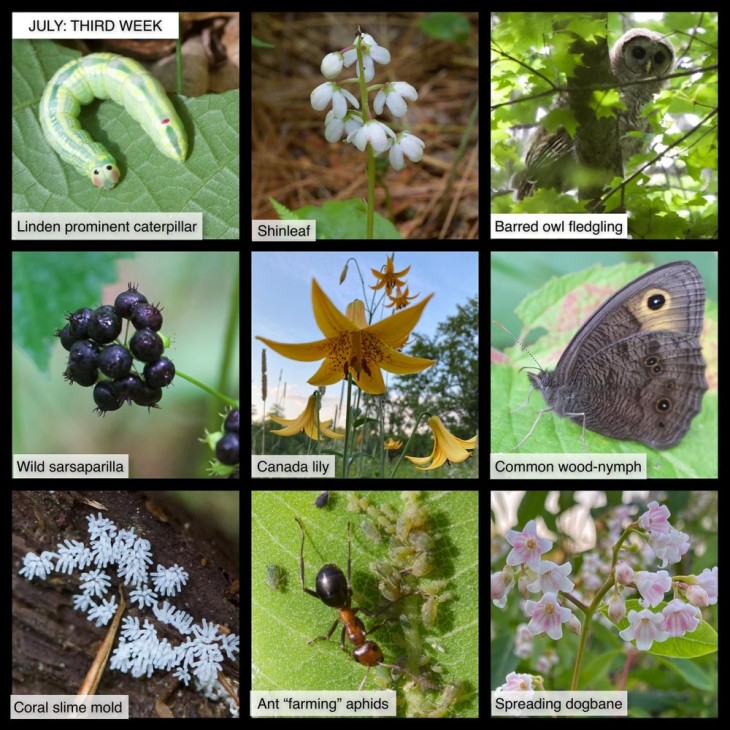This week in the woods, we stumbled upon this clown-faced caterpillar, which we had difficulty identifying. The linden prominent is common but hard to find; it clings to the undersides of American basswood leaves. The “prominent” part of its name apparently refers to the raised tufts on the adult moth’s wings. Here’s a link from BugGuide.net – a great online resource – with thanks to its volunteers for helping with identification.
There are several species of shinleaf coming into bloom now (including Pyrola elliptica, pictured here). You’ll often find these small wildflowers in moist woodlands. According to the Encyclopedia of North American Wildflowers (Parragon Publishing), the plants get their name from “a traditional practi[c]e of using the leaves as a plaster, known as a shinplaster, on bruises and wounds.” Here’s a profile from Adirondacks Forever Wild.
If you hear raspy shrieks and long hisses coming from the canopy, you may be in the presence of a fledgling barred owl. This year’s young are in a precarious stage between chick and competent adult. They’re working on their hunting skills, but they’re still clumsy flyers with baby fuzz, and they depend on their parents to supplement their food supply. Here’s a profile (including a sound file) from New Hampshire PBS’s “Wildlife Journal, Junior,” a good resource for families with young children.
Wild sarsaparilla’s black-blue berries are ripening. Its roots can be used for making root beers and teas, but the berries themselves are unpalatable and make some people sick. Confusingly, sarsaparilla is not the traditional ingredient for the popular 19th century drink sarsaparilla – which is made with the roots of a tropical vine. Here’s a profile from The Native Plant Trust.
The bright orange daylilies blooming now along roadways are naturalized garden flowers. However, Canada lily, also in bloom right now, is a just-as-spectacular native. Look for a large yellow lily with red freckles. The plant grows in sunny sites, for example in meadows, but it tends to be scarce in areas with heavy deer browse. Here’s an exquisite photo and discussion of the plant from Mary Holland’s Naturally Curious blog. As Holland notes, ruby-throated hummingbirds are frequent pollinators.
We’ve been noticing common wood-nymph butterflies in the fields for the past several days; you’ll often see them as dark, fast-flying butterflies that resist all efforts at a closer look. Here’s an Outside Story essay about them from Carolyn Lorié, who notes that she has often found them swarming the oregano in her herb garden.
Another common sight this past week: old logs splashed with what looks like bright white paint. On closer inspection, the splashes are revealed as tiny clusters of what appear to be tentacles. These are the spore-bearing structures of coral slime mold. Slime molds aren’t fungi, they are a diverse group of species that start life as single-cell amoeba-like organisms and later – wait for it – come together to form living blobs. In plasmodial slime molds such as coral slime, the amoeboids fuse to become one mega-cell containing multiple nuclei. There’s a lot more about these organisms that is mind-boggling. See for example, this BBC YouTube clip, which features slime molds “solving” a maze, and approximating the road system of metropolitan Tokyo.
Out in the milkweed patch, we have found ants farming aphids. As the aphids digest milkweed sap, they defecate sugary honeydew. The ants (multiple species) harvest the honeydew, and protect their aphid “flock.” However, some milkweed plants have evolved to interfere with this arrangement. By producing more toxins, the plants don’t kill their aphid pests, but they make the honeydew poisonous to ants. Without ants to guard them, aphids become easy prey for ladybugs, wasps and other predators. For more on the topic, see this summary of research by Cornell’s Anurag Agrawal.
While you’re out in the milkweed meadow, keep an eye out for the white-and-pink blossoms of spreading dogbane. This milkweed relative produces nectar that is popular with adult monarchs and other butterflies. In common with milkweed, its leaves also contain cardiac glycosides. The plant is not, however, a successful host for monarch caterpillars. Here’s a profile from the U.S. Forest Service.
Elise Tillinghast and Meghan McCarthy McPhaul contributed this week’s images.
In this difficult period, many of us find joy in observing local nature, and many families are seeking outdoor enrichment opportunities for children. Here are nine photographs taken this past week, most within 15 miles of the Northern Woodlands office in Lyme, New Hampshire. We hope you enjoy using this grid as a prompt for your own explorations, or as the basis for a game of family forest tic-tac-toe.
What are you seeing in the woods this week? Share your images with us on Facebook, or submit a special photo for possible inclusion in our monthly online Reader Photo Gallery.



Discussion *